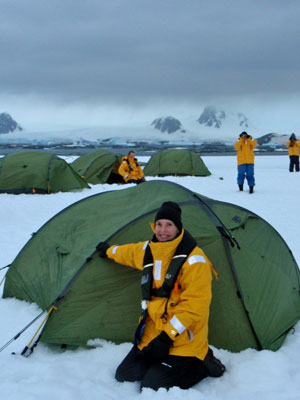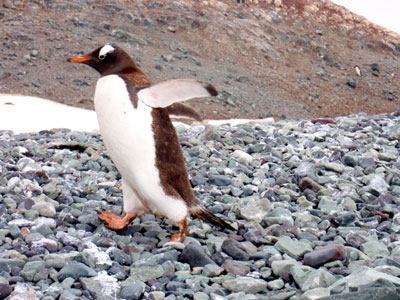Awed by the pristine beauty of Antarctica
This article appears on page 34 of the August 2013 issue.
by Nancy Tardy; Las Vegas, NV
It was in Punta Arenas, Chile, that I met the rest of the members of Quark Expeditions’ “Fly the Drake” tour to the Antarctic Peninsula. I had chosen this trip from Quark (Waterbury, VT; 888/979-0350) because it offered charter flights in both directions over some of the roughest water in the world, the Drake Passage, reducing the trip length by four days and resulting in a lower trip cost*.
The next-to-the-last trip of the summer season for the small ship Sea Adventurer fit my schedule best.
The ship
Our 110-person tour group left Punta Arenas on Feb. 7, 2013, taking back-to-back chartered flights to a Chilean military base on King George Island, the largest of the South Shetland Islands. From this remote, gravel landing strip, we walked over a mile along the runway and down to the shore, where motorized rubber boats called Zodiacs waited to ferry us to our ship.
The Sea Adventurer was well cared for and had a fun, enthusiastic staff dedicated to providing good service in one of the most remote areas in the world.
The food was plentiful and tasty and seemed to please everyone. Special diets were easily accommodated, and an all-inclusive beverage package eased the pain of the end-of-voyage bill paying.
Breakfast was served in two locations. The lounge was set up with a limited cold buffet plus coffee, tea and juices, while a sit-down breakfast was served in the dining room for those desiring heartier fare.
Lunch was always an extensive buffet, however evening meals offered more elaborate menu options and an opportunity to wear something other than fleece, though these were never dressy occasions.
The ship’s library provided regional books and maps, a computer with intermittent Internet access (using cards purchased at the reception desk) and assorted reading material. Having an onboard doctor, when the nearest medical facility was hundreds of miles away, eased my mind.
The logistics
Ours was a diverse group from 19 countries, and its members ranged in age from a teenager to 84-year-old Frank, an organic chemist and retired professor. Many were traveling to Antarctica to realize their goal of visiting all seven continents; for most of them, this was their final one.
While not extreme in its physical requirements, this was no cruise-ship voyage. It was an expedition in the truest sense of the word.
One could choose to spend the entire trip on the ship, but to really experience Antarctica one must go ashore when and where conditions permit, as ice moves constantly to block harbors and anchoring places. Transfers to and from shore were always made in the Zodiacs, which often required good balance and a bit of daring, depending on sea and weather conditions.
Each day, at least two — and sometimes three — excursions were scheduled. We visited penguin colonies, toured research stations and took advantage of hiking and photo opportunities. Weather and ice dictated where we could go and what we would see.
For an extra charge of $950 each, kayakers could go out with a guide each time shore excursions were loading. My kayaking skills are limited, so I booked an overnight camping trip instead.
Though I’m not a camper, even under the best of circumstances, the uniqueness of this opportunity was too great to ignore, so I paid the tariff of $225 and awaited the designated evening with a mixture of dread and excitement.
Memorable moments
The best part of the trip, for me, was a sunset Zodiac ride in a quiet bay filled with icebergs and surface polar ice. At 9 p.m., the sky’s colors tinted the water and ice a variety of pastel shades. Our Zodiac driver, who doubled as the ship’s photographer, gave us time to take photos, maneuvering the boat so that everyone had good views.
We quietly watched leopard seals eyeing us from nearby ice floes and motored along, photographing majestic icebergs with rich blue stripes.
With coffee cup in hand early one morning, I watched our passage through the Lemaire Channel, one of the most beautiful seascapes in the world. Glaciers and mountainsides plunged to the sea as the channel narrowed at the far end — a picture-perfect hour!
One busy day began with a visit to Wordie House, a small, restored British facility built in 1947 to house an overwintering British research team. The day ended with the camping expedition.
Inside the British hut were bunks for five men, a workspace/living area and a kitchen with only a stove, no refrigerator necessary. Tacked to a nearby wall was a yellowing list documenting the coal deliveries for the long winter neatly written in beautiful cursive.
Near Wordie House is the Ukrainian station Vernadsky, which is involved in various kinds of meteorological research and offers a visit to the southernmost public bar in the world, where $3 buys a shot of their homemade vodka.
Antarctic campout
Back on board, the gusty wind that had prevailed all day finally diminished enough for the picnic scheduled on the aft deck to proceed. Over a lovely, albeit cool, dinner of prime rib, salad, potatoes and dessert, I heard an overhead announcement: “Campers, come to the disembarkation point.”
Thirty of us, the maximum number allowed, headed for a tiny atoll in the Argentine Islands Archipelago that had been scouted and chosen earlier in the day by our camp leaders. After the lengthy Zodiac ride, we made our way up a slope of slushy snow, depositing our tents and sleeping bags at the rounded top, where we’d be safe from any mini-tsunamis caused by calving glaciers.
Our group made good progress pitching the small, 2-man pup tents in the cold, blustery wind on the high snowfield. We pegged the tents with snow anchors, braced them with large rocks from nearby outcroppings and shoveled piles of snow on the sides facing the incessant wind.
Nearby, a huge iceberg broke apart and turned belly up — a display of Mother Nature’s might that is rarely seen by travelers. The silence was almost palpable on this tiny bit of land that may have never hosted humans before.
A field of snow filled the lower third of our view, with ice-choked waterways separating our small island from towering mountain peaks visible on the far horizon — all under a lowering Antarctic sky that foretold the possibility of an overnight storm.
The night passed quickly, rain and sleet pelting the tent while the wind stayed steady, playing a tune on the tent’s guy-wires. Never really cold in my sleeping bag until morning, I was happy to help break camp.
As we made our transfer back to the ship, I shook my head in disbelief at this unbelievable opportunity to camp in an otherworldly, pristine wilderness area 1½ times larger than the entire United States.
Wildlife encounters
Visits to penguin colonies were highlights of this trip. Chinstrap, gentoo and Adélie penguins all were sighted at Petermann Island, Hannah Point and Half Moon Bay.
Cautioned to not approach the penguins, we waited for them to come to or near us, if they chose to. Often while clumsily hopping from their colony to the shore and back, they approached near enough for close-up photos to add to our albums and memories of Antarctica.
The expedition leaders, our Zodiac drivers, were a great resource in spotting and identifying the myriad birds, seals, whales and penguins active in the area during the short Antarctic summer. Each guide specialized in one particular area of geology, biology, ornithology or history. Lectures by the knowledgeable staff were an enjoyable and much-anticipated part of each day’s activities.
Preparations
Packing for a trip to Antarctica is a challenge. This 7-day trip, relying as it did on chartered planes, required its participants to carry no more than 20 kilograms, or 44 pounds. We were sent a list of essentials, which included two types of headgear, mittens, glove liners, waterproof pants, layers of breathable fleece tops and bottoms, and multiple pairs of socks.
Each tour member was loaned waterproof boots for wet shore landings and hikes along mucky surfaces, and yellow expedition parkas were given to all of us in Punta Arenas. With these two bulky items provided on site, I managed to pack everything into a small carry-on suitcase and a large purse.
My total expedition cost, including two nights at the Dreams Hotel in Punta Arenas, the camping expedition and all-inclusive beverage package, was $10,565, based on a double-occupancy room. Since I was traveling alone, I could have been assigned a roommate on the ship, though I was not.
In addition, I chose to purchase a trip-interruption/cancellation insurance policy from Travel Guard (Stevens Point, WI: 800/826-4919) for $504.
I flew American Airlines and LAN from Las Vegas round trip to Punta Arenas at a cost of $2,142. Remember, US citizens flying into Chile through Santiago International Airport are charged an entrance fee on arrival.
At our last supper on board, the ship’s photographer, Krystle, showed a DVD presentation that she had compiled from our tour members’ photos. Set to music, it was a thoughtful gift for each of us, providing vivid memories of this trip of a lifetime!
[*See the clarification "Drake Passage — sail, fly or both?" in the January 2014 issue. —Editor]




